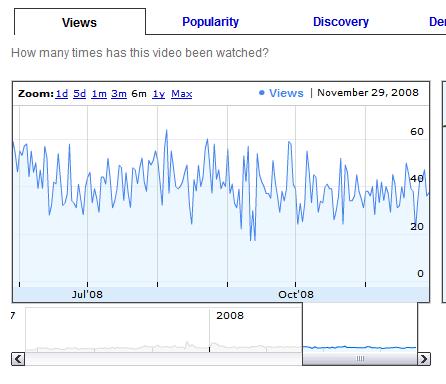Google started serving universal search results in May of 2007, and one of the key aspects was integration of videos into the search listings or SERP’s. This presented a unique opportunity for search marketers, the ability to leverage the domain trust of video sites, to penetrate the difficult and high competition searches. Additionally it allowed forward and progressive marketers to obtain deeper saturation on SERP pages where they already has visibility. In this article I’ll be taking a look at some video integration into search and some tips on how to help you get more out your videos.
First we’ll be taking a look at the video hosting services where you can upload you video, the major sites are Youtube, MetaCafe, Break, Veoh, Daily Motion, Vimeo, and Yahoo Video. Google video still exists but at this point it’s my opinion it exists only because of it’s legacy status within Google, and it is not something I’d spend a lot of time with. There are many more video hosting sites however Google Universal search has bias towards established and reputable sites with consistent up-time, so again in my opinion it’s only worth concentrating on the bigger video hosting websites.
From an SEO perspective the primary goal is to generate a universal result and secure one or multiple video listing results as shown in the screen shot below:

While Google keeps the algorithm of what exactly triggers a video listing to
appear a secret, there are certain factors which have been shown to play a role:
- Number of views – generally speaking the more views the better, but a minimum threshold exists, the lowest I have ever seen is in the 400 views range.
- Ratings – More ratings and higher ratings play a role. You don’t need to have 4 or 5 stars, but if there are competing videos ratings are part of the ranking and display algorithm.
- Comments – The number of comments plays a small role, you don’t need comments to get a universal listing but for competing videos comments are part of the algorithm.
- External Links – As with all SEO efforts links play a role, trusted links, authoritative links, number of links, topical relevancy, and inbound anchor text all play a part.
Start Your Video Optimization Plan
You should secure your domain name, or profile name on all of the major video services mentioned above, even if you don’t ever use them, it’s a smart strategy from a reputation management perspective. Next take a look at what your reach is, do you have thousands, hundreds, or significantly less people who make up your core audience via email, blogs, twitter or other social services. If you can leverage a large group of followers then you can use multiple services, smaller publishers are better sticking with one distribution channel, I suggest YouTube. Here are some key factors to consider when you upload your video. These are specific to YouTube but have carryover value to other services as well.
- Title – Strike a balance between keyword rich and interesting. Something like “Cheap Hotels, Book Cheap Hotel Rooms” is more desirable from a keyword perspective, but “How to Book a Cheap Hotel Room” is more interesting and click enticing. Try to form titles around actual search query terms.
- Description or Information – Include a URL, while most services will put a nofollow tag around it, it can still drive traffic. Be as succinct and and to the point as possible, include keywords, but focus on legibility. The point is not write a massive list of spam files meta description style keywords, but give useful information. Avoid “cheap hotel rooms, discount hotel rooms, budget hotel rooms”. Instead try something like “Not all business travelers have unlimited expense accounts, in fact many look for budget hotel rooms and discount hotel rooms whenever possible. Here are our top tips for finding a cheap hotel rooms that are easy on your wallet”
- Tags – Use high level category tags and specific low level tags. the key is to find keyword tags that have search volume.
- Choose the Proper Category – Proper categorization is key, I’d suggest knowing which category you are going to use before you even shoot the video. Realize that some categories take less views to become popular, use this to your advantage.
- Choose the Right Thumbnail – Youtube recently added the ability choose a thumbnail for the video, find the most compelling or view enticing image and select it. Don’t be deceptive.
- Social Aspects – I’d suggest allowing comments, votes, and ratings, since these all play a part of the ranking algorithm you need then to take full advantage of universal search.
- Distribution – I’d suggest allowing video responses and mobile playback, the more people who see your video the better
- Embed – This is one issue that causes a lot of discussion. I suggest allowing people to embed your video, the more people who promote it, view it, and link to it the better. To make sure you get full credit say and show the company name and URL at least once, and preferably at the beginning and end of every video.
- Time and Geographic Data – if this is important to the video or the keywords you are trying to rank for then enter the information, however it’s not mission critical.
Most people upload their videos whenever they become available without an overall strategy. In my experience it’s much more effective to approach it with an end goal in mind. Be aware that each category has a popular for the day, week, month, all time area. Youtube works off of a calender week not a rotating 7 day period, so videos released in the beginning of the week have more time to accrue views and make the list, than videos released later in the week. You can upload a video whenever you want, and mark it as private so you are in control of the release time and date. Coordinate your release with your blog, press release or other social bookmarking services to achieve the more bang for your buck by concentrating the number of views in a specific time frame. Getting to the “popular” section for the day/week/month will build off of itself getting you more exposure outside of your audience. Again since total views, ratings, and comments are part of the ranking algorithm, this is the outcome you want.
Plan you video releases much as you would a social media campaign. Having an existing network of friends who will view, vote, comment, and share your video is key to jump starting the process.
Use the insights section of Youtube for your videos to evaluate your video and look for indicators of what worked and what didn’t use this to improve future videos.

Lastly if you are going to put up more than a than a few videos on your site be sure to submit an XML video sitemap.








[…] arrangement I’ll be blogging weekly-ish over on DIR Journals you can check out my first post Tips for Optimizing for Universal Search: Video. Also you can read Using Social Media as a Sales Channel by Shana Albert, and SEM for Mom and Pop: […]
[…] Tips for Optimizing for Universal Search: Video – Includes factors that play a role in video rankings and a video optimisation plan. […]
[…] week we took a look at some tips for universal search optimization for video, in this post we’ll be looking at tips for optimizing for local […]
[…] arrangement I’ll be blogging weekly-ish over on DIR Journals you can check out my first post Tips for Optimizing for Universal Search: Video. Also you can read Using Social Media as a Sales Channel by Shana Albert, and SEM for Mom and Pop: […]
[…] Gray offers great tips on how to do SEO for video content, and recently published a guest article by Gab Goldenberg on how to be […]
[…] Gray offers great tips on how to do SEO for video co&#…, and recently published a […]
[…] Tips for Optimizing for Universal Search: Video […]
Did you do the shave your back videos 🙂 I think this could work well for local information e.g. maybe videos of local parks, restaurants but using Youtube as it gets prominence in Google SERPS, if done as you say so.
Did you do the shave your back videos 🙂 I think this could work well for local information e.g. maybe videos of local parks, restaurants but using Youtube as it gets prominence in Google SERPS, if done as you say so.
[…] Gray offers great tips on how to do SEO for video content, and recently published a guest article by Gab Goldenberg on how to be […]
[…] Gray offers great tips on how to do SEO for video content, and recently published a guest article by Gab Goldenberg on how to be […]
[…] Gray offers great tips on how to do SEO for video content, and recently published a guest article by Gab Goldenberg on how to be […]
[…] Gray offers great tips on how to do SEO for video content, and recently published a guest article by Gab Goldenberg on how to be […]
[…] Gray offers great tips on how to do SEO for video content, and fresh publicised a guest article by Gab Goldenberg on how to be […]
[…] Tips for Optimizing for Universal Search: Video […]
[…] Create interview or instructional style videos and upload them to video sites such as YouTube (see tips for video optimization ). Be sure to insert your name or your company name in the title of the video, and link to it using […]
[…] Gray offers great tips on how to do SEO for video content, and recently published a guest article by Gab Goldenberg on how to be […]
[…] Gray offers great tips on how to do SEO for video content, and recently published a guest article by Gab Goldenberg on how to be […]
[…] Gray offers great tips on how to do SEO for video content, and recently published a guest article by Gab Goldenberg on how to be […]
Videos are effective tools that can be used to advanced any information, but for these videos to be effective these should be done the right way.
Videos are effective tools that can be used to advanced any information, but for these videos to be effective these should be done the right way.
[…] a video result in Google’s universal search, please read the Michael Gray’s awesome article on optimizing for universal search on Directory […]
[…] please read the Michael Gray’s awesome article on optimizing for universal search on Directory […]
[…] análisis para posicionar los vídeos en el universal search de Google (en las serps de Google) llega prácticamente a las mismas conclusiones, y no solo para Youtube, […]
[…] análisis para posicionar los vídeos en el universal search de Google (en las serps de Google) llega prácticamente a las mismas conclusiones, y no solo para Youtube, […]
Great post on video optimization!
If I can add a tip, try to use keywords also for the name of the video file.
It is not paramount if you are operating on YouTube only, as the file name get lost in the YouTube coding – but other video sharing sites could convert your original video file into a .flv file maintaining the original file name, which will enrich with further keywords the code of the video page. SEO is never enough! =)
This is a best video sharing sites, i like it!!!!!!!!!!!
Last week we took a look at some tips for universal search optimization for video, in this post we'll be looking at tips for optimizing for local.
In this four hour training session, attendees would find out essential mobile advertising schemes that are drawing mobile dealings today.
Optimizing Video Thumbnails for Google … search results, and tips for how you can do this yourself. ..
I will be writing about product search. Universal Search, Lesson . Image and Video Search.
Shari Thurow is the founder and search engine optimization (SEO) director at …. are still providing quick and easy tips for optimizing videos for Google Video.
Video is certainly the next important step in influencing search engine results. I created video posts for hotels NY midtown as you suggested and I've noticed a considerable growth in traffic to the site. SERP's work like a charm and people are more interested when faced with images.
Thanks for the post. Very informative for us lowly SEOs
Your article is really helpful! I seldom use video optimization.
Thanks for this information! I am going to check out the other video posting sites which I didn’t even know existed!
Really this article help me to learn how to optimize video for marketing. but tell me which is the best option to get back links for video marketing
Thanks for the article Mike. It’s hard to find some genuine info on what it takes to rank a video in google. Do you know of an way to check how far away you are from beating out a competitor who has first position on google? It all seems like a bit of a guessing game to me, which is really frustrating. Thanks again, Jon.
Really informative article post.Thanks Again. Awesome. deedecacgkfd
[…] a video result in Google’s universal search, please read the Michael Gray’s awesome article on optimizing for universal search on Directory […]